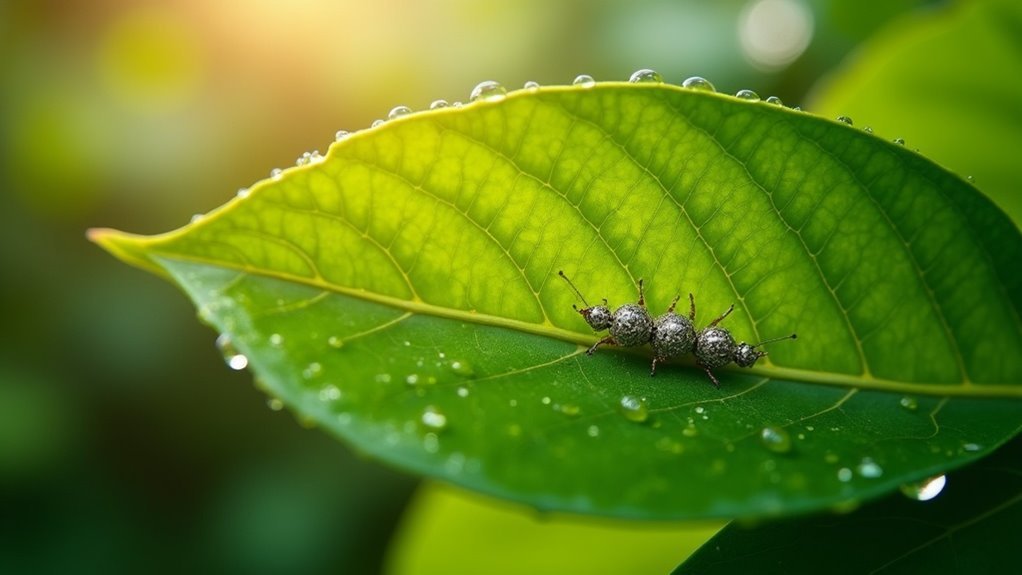The Coffee Leaf Miner (CLM), or Leucoptera coffeella, poses a significant threat to coffee crops. Its larvae burrow into the leaves, causing damage that can diminish your yield by as much as 40%. Look out for signs such as pale yellow trails and irregular brown spots on the leaves, which indicate an infestation. To ensure sustainable coffee production, effective management is crucial. This includes employing methods like biological control and integrated pest management for optimal results. Explore effective strategies to combat CLM and protect your coffee harvest.
Key Takeaways
- Coffee Leaf Miner (CLM), scientifically known as Leucoptera coffeella, poses a significant threat to coffee crops.
- The larvae of CLM create mines within coffee leaves, resulting in considerable damage and a decrease in yield.
- Infestations can lead to a reduction in coffee crop yields by as much as 40% due to impaired photosynthesis.
- Effective management strategies for CLM include integrated pest management (IPM) and various biological control methods.
- Regular monitoring and the implementation of cultural practices are crucial for the prevention and control of CLM infestations.
Symptoms of Coffee Leaf Miner Infestation
When you observe the symptoms of a Coffee Leaf Miner infestation, you’ll notice distinctive signs that indicate the presence of Leucoptera coffeella, a pest that significantly impacts coffee plants.
The larvae create pale yellow trails beneath the leaf epidermis, which lead to irregular brown spots on the upper surface. These spots reflect extensive mining activity, compromising the leaf’s ability to photosynthesize effectively.
The larvae form pale yellow trails under leaves, causing irregular brown spots that hinder photosynthesis.
As the damage progresses, you may see large necrotic patches and even bending of the leaves. If left untreated, this infestation can lead to premature leaf drop and reduced leaf area, potentially decreasing your coffee yield by up to 40%.
Recognizing these symptoms is vital for effective management and ensuring healthy coffee production.
Causes of Damage by Leucoptera Coffeella
Understanding the causes of damage by Leucoptera coffeella is crucial for coffee production. The damage primarily stems from two factors: the feeding behavior of the larvae and environmental influences.
The larvae create mines in the coffee leaves, which compromise their integrity, making them more susceptible to stress. Additionally, conditions such as dry seasons and high temperatures can worsen infestations.
If these issues aren’t managed effectively, they can result in significant economic losses for coffee growers.
Larval Feeding Behavior
As the larvae of Leucoptera coffeella burrow into coffee leaves, they initiate a destructive feeding behavior that considerably compromises the health of coffee plants.
These transparent larvae, reaching up to 3.5 mm, primarily feed on the mesophyll layer beneath the leaf surface. This mining creates pale yellow trails that evolve into irregular brown spots on the upper leaf surface, ultimately leading to leaf necrosis.
Such damage impairs photosynthesis and can potentially reduce coffee yields by up to 40%. The larvae’s behavior can result in severe defoliation, weakening the plant’s structural integrity and nutrient absorption, and, if left untreated, may even lead to plant death.
Protecting coffee plants from these pests is crucial for maintaining healthy crops and ensuring optimal coffee production.
Environmental Influences on Infestation
Environmental factors play a crucial role in the dynamics of Leucoptera coffeella infestations, directly affecting the extent of damage to coffee plants.
During dry seasons and high temperatures, the larvae thrive, leading to increased reproduction and subsequent leaf mining. This activity manifests as irregular brown spots on coffee leaves, which hinder photosynthesis and can result in defoliation.
Additionally, environmental stressors like drought or nutrient deficiencies can weaken coffee plants, making them more susceptible to infestations.
The timing of egg deposition on the upper surfaces of coffee leaves is critical, as favorable conditions can significantly enhance the success of these damaging infestations, further exacerbating their impact on coffee crops.
Control Recommendations for Coffee Leaf Miner
To effectively manage Coffee Leaf Miner in coffee cultivation, you should implement integrated pest management (IPM) strategies that encompass cultural, biological, and chemical controls.
Regular monitoring and the use of natural predators can enhance pest suppression in coffee plants.
Additionally, using chemical options judiciously helps mitigate resistance and environmental impact while maintaining the health of your coffee crops.
Integrated Pest Management Strategies
Implementing effective integrated pest management (IPM) strategies for Coffee Leaf Miner (Leucoptera coffeella) is essential for maintaining healthy coffee plantations.
Consider these approaches:
- Regularly prune and destroy infested leaves to curb CLM populations, ensuring the vitality of your coffee plants.
- Utilize biological control agents like parasitoid wasps to naturally suppress pest numbers, promoting a balanced ecosystem within your coffee farm.
- Employ pheromone traps for monitoring CLM, enabling timely interventions and safeguarding your coffee crops from damage.
Biological Control Agents
While chemical insecticides have been a traditional approach to managing Coffee Leaf Miner (CLM), integrating biological control agents like Ceraeochrysa cubana offers a more sustainable solution for coffee cultivation.
The larvae of C. cubana actively prey on various CLM life stages, particularly excelling at consuming CLM eggs and pupae. Remarkably, second and third instar larvae enhance predation efficiency, significantly contributing to pest population reduction.
Promoting natural enemies like C. cubana not only alleviates dependence on chemical insecticides but also fosters ecological balance in coffee plantations.
Chemical Control Options
Effective management of Coffee Leaf Miner (CLM) is crucial for maintaining the health of coffee plants and ensuring high-quality yields. A strategic approach to chemical control options that aligns with Integrated Pest Management (IPM) principles is essential.
Here are some key strategies to consider:
- Careful use of systemic insecticides, particularly neonicotinoids, is important to prevent the development of resistance among pest populations.
- Implementing pheromone traps can help monitor and disrupt CLM mating patterns, thereby reducing the need for chemical applications.
- Rotating different classes of insecticides can be effective in managing resistance and protecting beneficial non-target organisms.
Regular monitoring of pest populations is vital for timely interventions, ensuring that treatments are both effective and environmentally responsible.
Prevention Strategies for Coffee Leaf Miner
To effectively manage Coffee Leaf Miner (CLM) infestations in coffee plantations, integrating various prevention strategies is essential.
Regular monitoring for early signs of damage, such as pale yellow trails and irregular brown spots on coffee leaves, allows for prompt intervention.
Regularly check for pale yellow trails and brown spots on coffee leaves to ensure timely intervention against Coffee Leaf Miner damage.
Enhancing biodiversity in coffee farms by promoting beneficial insects, like parasitoid wasps, can naturally suppress CLM populations.
Implementing cultural practices, including pruning infested leaves and maintaining field sanitation, is vital in preventing the spread of CLM.
Furthermore, utilizing pheromone traps helps monitor CLM populations, optimizing the timing of interventions while reducing reliance on chemical controls, ultimately supporting sustainable coffee farming practices.
Impact on Coffee Crop Yields
The presence of Coffee Leaf Miner (CLM) can significantly affect coffee crop yields, with reductions of up to 40% reported due to its destructive mining behavior.
The larvae’s feeding on mesophyll tissue creates pale yellow trails and irregular brown spots, leading to severe defoliation. This results in:
- Reduced leaf health, impairing photosynthesis
- Premature leaf drop, which adversely affects berry production
- Economic losses for coffee farmers
Implementing effective pest management strategies is crucial, as substantial infestations not only diminish crop quality but also jeopardize the sustainability of coffee farming.
Understanding the impact of CLM is essential for preserving healthy coffee yields.
Biological Control Agents
While traditional pest management methods often rely on chemical insecticides, integrating biological control agents like Ceraeochrysa cubana offers a sustainable alternative for managing Coffee Leaf Miner populations, which can severely impact coffee crops.
The larvae of Ceraeochrysa cubana actively prey on Leucoptera coffeella eggs and immature stages, greatly hindering the development of this pest that threatens coffee quality and yield.
Research shows that second and third instar larvae effectively consume Leucoptera coffeella pupae, leading to a significant reduction in overall pest numbers.
Integrated Pest Management Practices
Implementing Integrated Pest Management (IPM) practices for Coffee Leaf Miner (CLM) is essential for maintaining a healthy coffee ecosystem.
Implementing IPM practices for Coffee Leaf Miner is crucial for a thriving coffee ecosystem.
Enhancing the effectiveness of biological control agents, such as Ceraeochrysa cubana, is key to sustainable coffee cultivation. By integrating various strategies, you can effectively minimize CLM populations:
- Regularly monitor CLM using pheromone traps to ensure timely interventions for control.
- Employ cultural practices, including the pruning of infested leaves and maintaining cleanliness in the coffee plantation, to reduce infestation levels.
- Introduce natural enemies like parasitoid wasps to strengthen biological control efforts.
Additionally, rotating insecticides within your IPM framework helps manage resistance while reducing the chemical impact on the environment, ensuring a healthier coffee crop and effectively controlling CLM.








